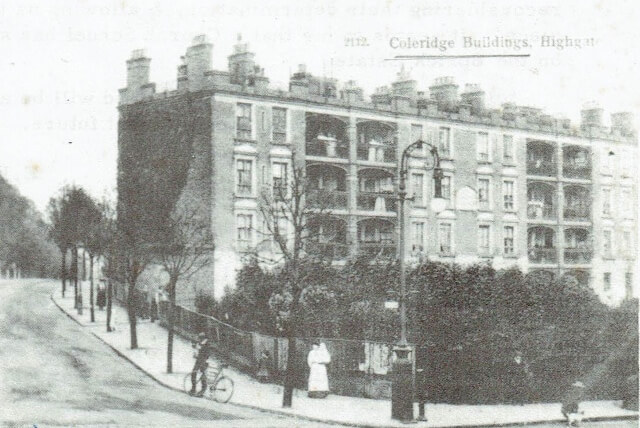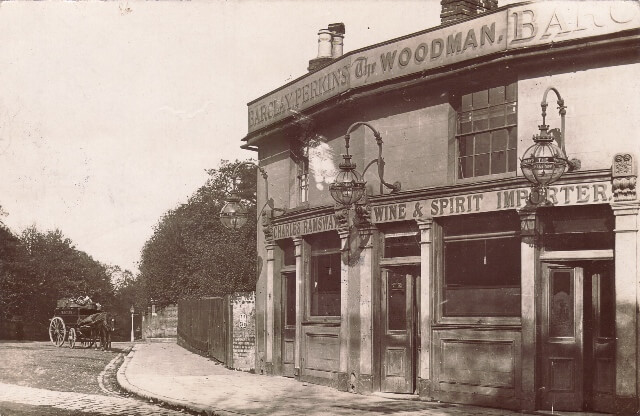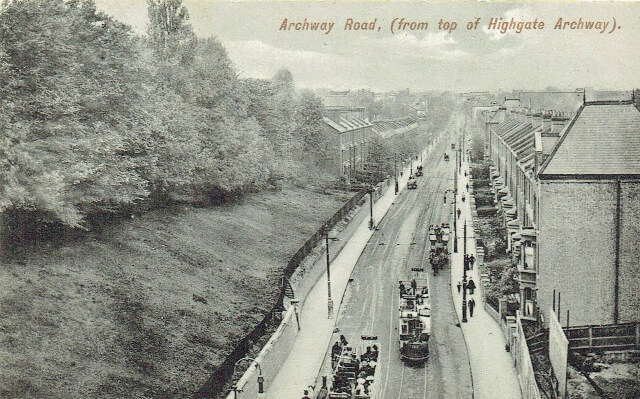
The extension of the Great Northern Railway and the opening of Highgate Station in 1867 caused a rush of development and in the next twenty years streets devoured most of the fields. Many local land owners sold out to builders; land that had cost £60-£70 per acre changed hands at £1000. So did the successors of Squire Jackson, for the construction of one of the railway tunnels. Nevertheless, the railway company made part of the site available for cultivation.
Adjoining it, built at about the same time, was a large block of what were intended to be model workers’ flats, called Coleridge Buildings. A similar block (still standing in 1973) called Verandah Cottages had been built in 1863 in North Hill by Rev. Josiah Viney, the local Congregational Minister and there were subsequent attempts, before the Highgate Dwellings Improvement Company was formed, to use Pond Square for this type of development.
These flats with their iron balconies and rationalised quota of rooms, were seen as a great advance over the ‘miserable hovels’ of lath and plaster construction and no sanitation. About 46 families of artisans lived in the Archway Road flats. One of the present allotment holders (1973), who has lived in the vicinity all his life, remembers that before Coleridge Buildings was demolished by a flying bomb in 1944 the occupants formed the bulk of allotment tenants.

The advantages of transport links
In mid-Victorian times the proximity of the railway and of a trunk road was considered an advantage. One of the most esteemed properties in the neighbourhood was that of Colonel Stedall, Chairman of the Local Board of Health (which preceeded the Borough Council), who lived in The Priory, a large house situated where Highgate Public Library is now, with extensive and elaborate gardens extending down the slope to a stream near the station.
Similarly, other properties were built in the meadows soon after the railway was opened, including the Station Master’s house, where Eton Court now stands, and the local doctor’s villa at 225 Archway Road. These people were not disturbed by rail or road traffic, nor was anyone even in the 1890s, according to a life-long resident Mrs Dawton of Holmesdale Road born before 1900 in Northwood Road (see 2 paragraphs below).

Building development continues
The later development of the area was almost entirely due to the railway with its fast services to town and not to the road, with its slow moving horse-drawn carriages and carts.
Innumerable clerks from the terraces and semis of the Miltons, and professional men from their detached splendour in Shepherds Hill, made the daily journey by train. The open space that remained has always made this a most desirable area for the commuter, for instance in 1887, a builder named Carter, advertising the ‘prettiest villas in Highgate’ to be let in Orchard Road, pointed out ‘charming back-scenery – cannot be overlooked’; this was temporarily true, since next to his street was the railway and beyond were still fields.
Mrs Dawson Remembers
Many people were employed in local shops and businesses and in domestic service. Such were the parents of Mrs Dawson who had come from the West Country to seek their fortune in London, the mother from Dorset to be engaged as a nursery maid to a well-to-do butcher in Shepherds Hill, the father with his brothers from Taunton, he to be employed as a decorator and one of them to found the estate agency of Edmund Cude. When she and her sisters were small their mother eked out their meagre income by taking in washing, notably from the police station which has moved from the little building opposite the Gate House to larger premises up Archway Road. The streets were quiet enough for the children’s games of hoops and marble.
Having to climb the hill made theirs a separate existence from the inhabitants of Highgate village, though they had to walk there to attend school. Considerable civic pride is indicated in the purpose-built shops of 1898-9 opposite Highgate Station with the title, still moulded in the brick work, of Grand Parade.
Life Goes on
The pattern of life today (1973) is basically similar to that of Edwardian times, despite the great expansion of freight traffic on the A1 since the Second World War and the constant noise of cars. The Underground performs the function of the disused railway for the commuter. As residents, people use the facilities of meeting places and churches, shops and doctors’ surgeries that have grown up largely as a matter of pedestrian convenience round the Archway Road. On 1st November 1973, a customer in Drew’s the greengrocer’s, scheduled for demolition under the Widening Scheme, was heard to say, “Just like a village round here – if it wasn’t for the traffic”.
Website editor’s note
This is the second part of an article, which appeared in HHS Quarterly Bulletin No. 1, Dec. 1973. It’s based on Historical Notes written by Joan Schwitzer, HHS Vice Chairman, on behalf of the Railway Allotments Group at the Archway Public Enquiry 1973. This had been prompted by a proposal to develop a motorway-standard dual carriageway road from the Wellington pub junction, north of Highgate village, and the old London County Council boundary at Archway Bridge. That proposal would have meant, (i) the demolition of about 170 houses and shops, (ii) increased deterioration in the environment, (iii) a blight on property and on the lives of many people in the area.